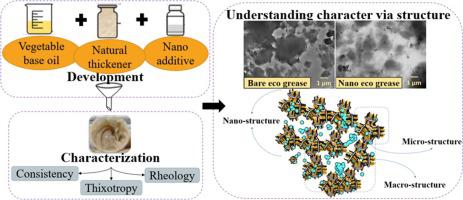Industrial Crops and Products ( IF 5.6 ) Pub Date : 2021-09-21 , DOI: 10.1016/j.indcrop.2021.114033 Ankit Saxena 1 , Deepak Kumar 1 , Naresh Tandon 1

|
The grease industry today is saturated with products based on petroleum/mineral oils and harsh (containing harmful chemicals) thickeners and additives. Such greases pose severe threats to the environment during their entire service life and even after being discarded as waste. To acknowledge the issue, researchers have developed a few eco-friendly alternatives (from natural and/or eco-friendly ingredients) so far; however, a potential solution is never reached. The present study puts forward a maiden combination to develop a series of greases using soybean oil as base oil, organo-montmorillonite as a thickener, and CaCO3 nanoparticles (0–3 %w/w) as additives. The developed gels were characterized for fundamental properties (consistency, thixotropy, and rheology) against an equivalent commercial grease to justify the signatures of a typical lubricating grease. Deep exploration of the microstructures was also carried out to understand the mechanism(s) behind the observations. In general, the developed gels exhibited equivalent characteristics to that of the commercial grease. However, the concentration of nanoparticles appeared to influence grease behavior significantly. The distribution of and the level of agglomeration among the nanoparticles were recognized as the two crucial parameters. Among all the formulations, the grease with 2% doping of CaCO3 nanoparticles displayed the optimum properties (thixotropy and rheology) closest to that of the commercial reference grease. Models are proposed to develop an explicit understanding of the grease structure, and TEM (Transmission Electron Microscope) micrographs are presented to support the hypothesis. The structure of the grease and the interaction(s) among various ingredients was observed as the fundamental factor governing the grease character.
中文翻译:

以植物油为基础的环保纳米润滑脂的开发:通过结构探索其特性
今天的润滑脂行业充斥着基于石油/矿物油和刺激性(含有有害化学物质)增稠剂和添加剂的产品。此类润滑脂在其整个使用寿命期间甚至在作为废物丢弃后都会对环境构成严重威胁。为了承认这个问题,到目前为止,研究人员已经开发了一些环保替代品(来自天然和/或环保成分);然而,永远无法找到潜在的解决方案。本研究提出了以大豆油为基础油、有机蒙脱石为增稠剂、CaCO 3的系列润滑脂的首次组合。纳米颗粒 (0–3 %w/w) 作为添加剂。开发的凝胶的基本特性(稠度、触变性和流变学)与等效的商业润滑脂相比,以证明典型润滑脂的特征是合理的。还对微观结构进行了深入探索,以了解观察背后的机制。一般来说,开发的凝胶表现出与商业润滑脂相同的特性。然而,纳米颗粒的浓度似乎显着影响润滑脂的行为。纳米颗粒之间的分布和聚集程度被认为是两个关键参数。在所有配方中,CaCO 3掺杂量为 2% 的润滑脂纳米颗粒显示出最接近商业参考润滑脂的最佳性能(触变性和流变学)。提出模型以明确了解润滑脂结构,并提供 TEM(透射电子显微镜)显微照片以支持该假设。润滑脂的结构和各种成分之间的相互作用被认为是控制润滑脂特性的基本因素。











































 京公网安备 11010802027423号
京公网安备 11010802027423号